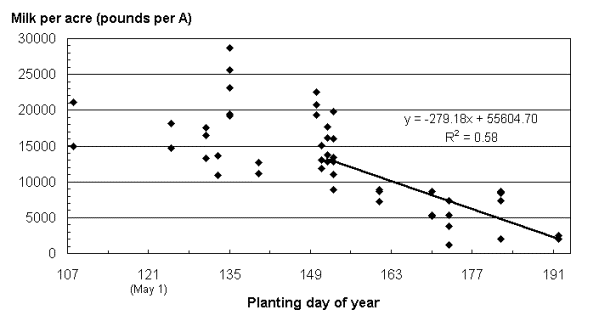
Corn silage response to planting date
June 18, 1998 5(13):73-74
Joe Lauer, Corn Agronomist
Often late planted corn ends up being ensiled rather than used as corn for grain.
In most situations, the yield/moisture trade-off between decreasing yield and increasing
drying costs with later planting dates warrants this decision. The standard recommendation
for late planting corn grown for grain is that it should not be planted after June
5 in northern WI and June 10 in southern WI. But how late should we plant corn intended
for silage use? Again, the standard recommendation is to not plant corn for silage
after June 10 in northern WI and June 20 in southern WI.
This may be an appropriate recommendation when thinking of silage for yield only.
It may not be a valid recommendation when thinking of silage in terms of yield and
quality (milk per acre). Figure 1 shows the milk per acre response to planting date
of several corn hybrids grown at Arlington, WI between 1994 and 1997. On average
over all years and hybrids, corn planted between April 18 and May 15 produced 18,000
pounds of milk per acre. Milk per acre starts to decline after May 15. Beginning
June 1, 279 pounds of milk per acre is lost with each planting day delay.
By June 10, about half of the yield potential is lost for corn grown for grain.
Similarly, for corn grown for silage about half of the yield and quality potential
(milk per acre) is lost by June 10. However, the economic swing is much greater.
For example, the economic swing for corn grain using a 150 bu/A yield level equals
$188 (75 bushels x $2.50 excluding drying costs). For corn silage, the economic
swing using an 18,000 pounds of milk per acre yield level equals $900 (9,000 milk
per acre x $10.00 cwt).

We are not truly comparing apples to apples in this example, but for the dairy farmer
that produces all of his feed on-farm, late planting decisions for silage need careful
consideration. There are many economic factors that enter into this decision like
buying back cheaper grain to improve the quality of late planted silage, year-to-year
variability, shorter-season hybrid performance, grain price, milk price, drying
costs, etc. Clearly though losing 279 pounds of milk per day is much more economically
consequential than losing 4 to 5 bushels of grain per day.